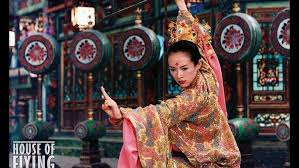Few moments in martial arts cinema have captured audiences quite like the dummy scene in House of flying daggers dummy scene. Directed by Zhang Yimou, the film is widely celebrated for its combination of poetic storytelling, emotional intensity, and visual grandeur. Among its many unforgettable sequences, the dummy scene stands out as a perfect balance of character development and cinematic artistry. More than just a demonstration of martial prowess, it is a sequence rich with symbolism, foreshadowing, and narrative weight.
The Symbolism Behind the Dummy Scene
Zhang Yimou’s films are often praised for their layered meanings, and the dummy scene is a prime example of how action can serve as a metaphor for deeper truths.
Representation of Inner Strength
Mei, blindfolded and facing the challenge of striking the drums through sound and intuition, embodies the theme of inner power. Her ability to succeed in the task despite her supposed blindness showcases resilience, instinct, and the idea that true strength often comes from within rather than what the eyes can see.
The Contrast of Violence and Beauty
Although Mei’s task is inherently violent—striking at wooden dummies—it is presented with extraordinary grace. Every movement flows like a dance, turning aggression into artistry. This delicate balance of brutality and elegance reflects the film’s overarching motif: beauty can exist even in conflict.
Foreshadowing of Relationships and Betrayals
What appears to be a simple demonstration of skill subtly foreshadows the complexity of Mei’s relationships. The tension, admiration, and emotional undercurrents between characters in this moment serve as an early signal of the betrayals and shifting loyalties that will later define the story.
Choreography and Cinematic Techniques
The dummy scene is a technical marvel, blending martial artistry with carefully orchestrated cinematic choices.
Use of Camera Angles and Movement
The camera doesn’t just record the action—it participates in it. Wide sweeping shots highlight the spatial choreography, while close-ups draw viewers into Mei’s determination. Slow-motion emphasizes precision and intensity, ensuring each strike carries weight both visually and emotionally.
Sound Design and Musical Score
The scene’s auditory design is just as critical as its visuals. Each strike against the drum reverberates, echoing like a heartbeat that synchronizes with the audience’s anticipation. The rhythmic sound, paired with strategic silences, creates suspense while underscoring the dramatic tension between the characters.
Costume and Set Design’s Role
Mei’s flowing attire enhances the scene’s balletic quality, while the dummies themselves, arranged in a circle, symbolize confinement and challenge. The contrast of vibrant costumes against the earthy wooden structures creates a visual metaphor: human grace triumphing over mechanical obstacles.
Character Development Through the Dummy Scene
More than a spectacle, the dummy sequence plays a pivotal role in shaping our understanding of the central characters.
Mei’s Introduction as a Warrior
The scene introduces Mei as more than a dancer or entertainer—she is revealed as a figure of resilience and hidden strength. Her grace and mastery of the blindfolded test establish her as both formidable and enigmatic, setting the tone for her arc in the film.
Jin’s Perspective as an Observer
Jin’s gaze during the scene provides another layer of interpretation. His mixture of curiosity, admiration, and subtle intrigue foreshadows the emotional entanglement that will develop between him and Mei. For the audience, his role reminds us that the dummy scene is not only a performance but also a moment of connection.
The Role of Authority and Testing
The sequence is staged as a trial, designed to measure loyalty and skill. Authority figures look on, questioning not just Mei’s abilities but also her trustworthiness. This theme of testing—both in combat and in emotional truth—resonates throughout the film’s narrative.
Lasting Impact on Martial Arts Cinema
The dummy scene has secured a permanent place in the canon of martial arts cinema. Its influence can be seen in later films that attempt to blend martial choreography with symbolic storytelling. The sequence redefined expectations for how action scenes can function—not simply as fights, but as layered expressions of character and theme.
Internationally, this moment helped introduce wider audiences to the unique style of Chinese wuxia, where martial combat transcends violence to become a form of poetic art. Even years later, the scene is frequently revisited, analyzed, and admired by film scholars and fans alike.
✨ In conclusion, the dummy scene from House of Flying Daggers is far more than a showcase of technical brilliance. It is a pivotal narrative device, a symbolic performance, and a lasting contribution to global cinema. By merging elegance with intensity, it illustrates why Zhang Yimou’s work continues to resonate with audiences and influence filmmakers around the world.








